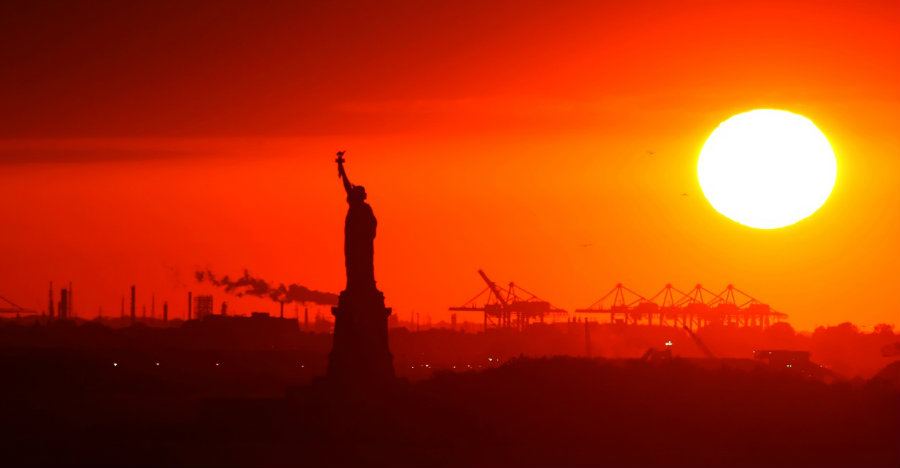It was announced that 2016 became the hottest year on record for the Earth. According to the National Oceanic and Atmospheric Administration (NOAA), the average surface temperature in 2016 was 58.69 degrees Fahrenheit. This also makes 2016 the third year in a row to break global heat records since 1880.
2016 was full of heat waves, severe storms, wildfires, ice-melt and the presence of phenomena such as El Niño. Human activities are damaging the planet, and it is something we cannot longer ignore for 2016 has become the hottest year on record. The announcement was made by NOAA, NASA confirmed so using other method and the World Meteorological Organization made a statement on the matter on Wednesday morning.

“A single warm year is something of a curiosity,” Deke Arndt, NOAA’s chief of global climate monitoring. “It’s really the trend, and the fact that we’re punching at the ceiling every year now, that is the real indicator that we’re undergoing big changes.”
16 of the 17 hottest years have occurred since 2000
Once, the years with heat records were anomalies. Now it seems that we are getting used to experiencing hotter temperatures each year. According to scientists, though there are many factors, the main cause of this problem is the human burning of fossil fuels. They say that the earth is going through big changes and these changes are caused by Greenhouse gas emission.
2016 has become the hottest year on the earth since the temperatures started being tracked back in 1880, as it was announced Wednesday by the World Meteorological Organization, a specialized agency of the United Nations. As well, 2016 has set global warm record for the third consecutive year. This was also announced by NASA and NOAA, who held a joint press conference to discuss the matter.
These agencies said that out of 17 years, 16 have shown heat records since 2000. The last time we had a cold year record was in 1911, more than a century ago. Temperatures in Earth during 2016 were 1.1 degree Celsius, or 1.98 degrees Fahrenheit, above the preindustrial levels. This means that we almost on the limit of warmth set by the Paris Agreement in December 2015.
One of the biggest concerns is the Arctic since it is warming twice as fast as the rest of the world. While the global temperatures were about 1 degree Celsius above preindustrial levels, the Arctic’s reached 3 degrees Celsius. As well, the ice minimum records have been continuously broken in both the Arctic and the Antarctic. This is not a problem just for polar bears, but the entire population living in the Arctic.
To get to these results, the World Meteorological Organization compared different global temperature databases made by several institutions such as NOAA, NASA, the European Weather and Climate Center and the UK Met Office.
The blame isn’t on ‘El Niño’, it is human-caused climate change
It is true that ‘El Niño’ phenomenon was present from 2015 to 2016, and it has a role in the increasing temperatures experienced worldwide. El Niño is a weather phenomenon that warms the Pacific Ocean, and it can contribute to excessive heat released to the atmosphere.
But the 2016 records can’t be blamed on ‘El Niño’ since it is just one among many factors. According to Gavin Schmidt, director of NASA’s Goddard Institute of Space Studies, only 12 percent of 2016’s temperatures can be linked to the phenomenon, but they were mainly caused by burning fossil fuels, which is a human action.
“The record is due to a combination of the (natural) strong 2015-2016 El Niño (warming of the tropical Pacific Ocean surface) and the strong global warming trend that has continued from 1970 to the present,” said James Hansen, former director of the NASA Goddard Institute for Space Studies. “The human-caused, long-term warming trend is the bigger contributor,” he added.
They said that the temperature records were caused in second place by the pollution.
Will the hot trend continue in 2017?
The effects of human activity are in no way subtle. They can be seen in the form of floods, droughts, hurricanes, wildfire among others. 2016 just continued a long-term trend that has been undergoing mainly since the 1970s. Therefore many believe that 2017 will likely break the global heat records once again.
However, it is unsure because ‘el Niño’ will not probably be present in 2017, which is a factor that could decrease the temperature, but it doesn’t mean that climate change suddenly stops. According to Schmidt, 2017 will be a top-5 year for global warming.
“Though some years will be warmer than others, the overall trend over multiple decades will inevitably be upward as long of concentrations of CO2 in the atmosphere keep increasing,” said Gerald Meehl, a senior scientist at the National Center for Atmospheric Research.
But if the Greenhouse emissions continue at the current rate, we won’t be able to stay below the 2-degrees Celsius goal established by 125 countries in the Paris Agreement, and the consequences will increase as well, meaning more natural disasters, fewer resources, extinction of species and so on.
Source: CNN
